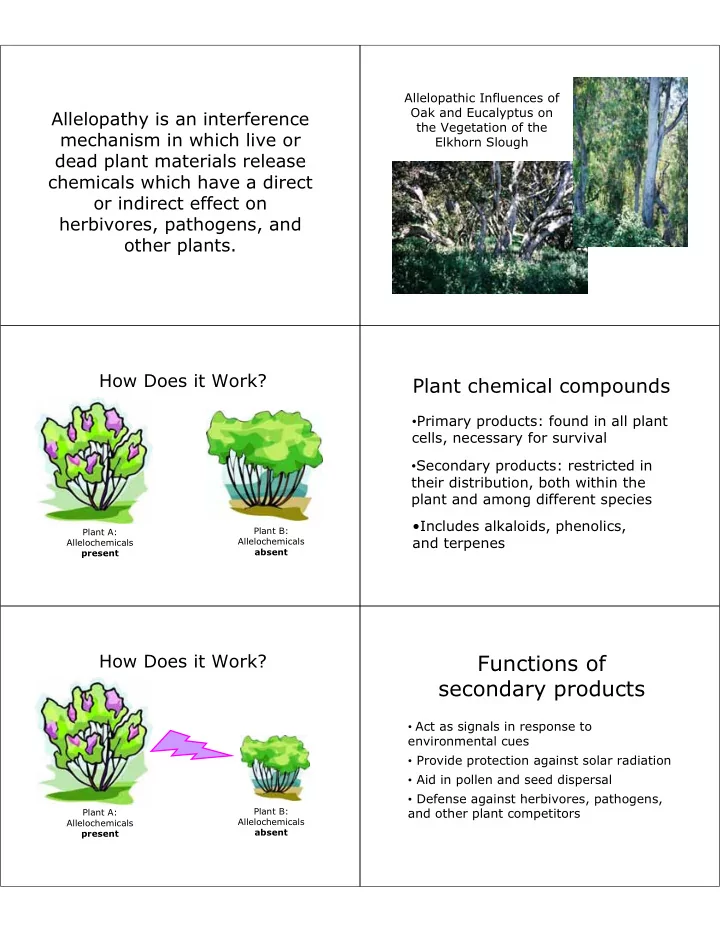

Allelopathic Influences of Oak and Eucalyptus on Allelopathy is an interference the Vegetation of the mechanism in which live or Elkhorn Slough dead plant materials release chemicals which have a direct or indirect effect on herbivores, pathogens, and other plants. How Does it Work? Plant chemical compounds • Primary products: found in all plant cells, necessary for survival • Secondary products: restricted in their distribution, both within the plant and among different species •Includes alkaloids, phenolics, Plant B: Plant A: and terpenes Allelochemicals Allelochemicals absent present How Does it Work? Functions of secondary products • Act as signals in response to environmental cues • Provide protection against solar radiation • Aid in pollen and seed dispersal • Defense against herbivores, pathogens, Plant B: Plant A: and other plant competitors Allelochemicals Allelochemicals absent present
How Does it Work? How Does it Work? Plant B: Plant B: Plant A: Plant A: Allelochemicals Allelochemicals Allelochemicals Allelochemicals absent absent present present How Does it Work? How Does it Work? Plant B: Plant B: Plant A: Plant A: Allelochemicals Allelochemicals Allelochemicals Allelochemicals absent absent present present How Does it Work? My research: • Investigated the direct effect of allelochemicals derived from the leaf litter of Quercus agrifolia and Eucalyptus globulus on native and non-native understory plants • Carried out a series of germination experiments, in which seeds were exposed to varying light intensity, substrate composition, and concentrations of leaf litter Plant B: Plant A: leachate Allelochemicals Allelochemicals absent present
Allelopathic compounds • Oaks produce mostly tannins, which are a sub-group of phenolics The Growing Structure • Eucalyptus produce several compounds, mostly terpenes and phenolics Seed bank composition 40 35 Total plants germinated 30 Seed bank 25 Euc 20 Oak 15 comparison 10 5 0 m s s s m a a s s r s i u u v u u s e l i t u a l r a h a i l a n h e l a i g a d r t h a i c p M l g o a G o h o n p n y f p p o n n e r A C e a o S w w c R n o P o o e n a n n h c k k t y C i n n n p U U o s M u u d r a C Sample collection Sax, 2002 •Showed similar species richness and diversity for oak and eucalyptus understory plants •Majority of species sampled did not occur in both woodland types, with only 39% in common between the two
Seed bank results: Effect of same source leachate Leachate Oak 1A seed Eucalyptus 1A bank seed bank 12 12 Mean seeds germinated effects on 10 10 8 8 6 6 seed bank 4 4 2 2 0 0 DI Euc DI Oak Somewhat significant for Euc p = 0.091 Two-way ANOVA Drip method Leachate leachate extraction effects on indicator seeds Seed bank in 50% shade Concentrated leachate Same source leachate De-ionized water extraction Euc Oak Euc Oak
Germination in Petri dishes Germination of Achillea millefolium 22.5 On paper: Day 9 On soil: Day 13 Mean seeds germinated 20 17.5 15 12.5 10 10 7.5 8 6 5 4 2.5 2 0 0 DI Euc Oak DI Euc Oak Significant for Oak p = 0.0040 Euc p = <0.0001 Two-way ANOVA Germination of Germination of Mimulus aurantiacus Bromus maritimus On filter paper: Day 9 On filter paper: Day 9 On soil: Day 13 10 25 25 Mean seeds germinated 22.5 22.5 Mean seeds germinated 8 20 20 17.5 17.5 6 15 15 12.5 12.5 4 10 10 7.5 2 7.5 5 5 0 2.5 2.5 DI Euc Oak 0 0 Euc DI Oak Significant for DI Euc Oak Oak p = 0.0059 Significant for Oak Euc p = 0.0059 Two-way ANOVA p = 0.043 Two-way ANOVA Germination of Baccharis Conclusions On soil: Day 13 On filter paper: Day 9 •Seedbank composition: common 18 18 dominants, and same level of diversity 16 16 Mean seeds germinated 14 14 •Eucalyptus and oak weakly suppress 12 12 natural seed bank germination 10 10 8 8 •Different species have different 6 6 responses to leachate exposure 4 4 2 •For some species, the soil may buffer 2 0 0 the interference mechanism DI Euc Oak DI Euc Oak Two-way ANOVA
Future questions •Experiment with different understory plant species •Manipulate the leachate concentrations •Explore leachate chemical composition •Assess and modify the light intensity •Adjust the leaf litter thickness •Consider a broader geographic scope Special thanks to: Jill Bushakra Kerstin Wasson ESNERR Cabrillo College Chemistry Department S & S Seeds, Inc.
Recommend
More recommend